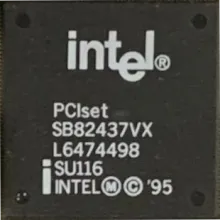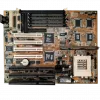
The SB82437VX, also known as the Intel VX chipset, is an older chipset designed for use with Intel 486-class processors. Introduced in the early 1990s, this chipset played a crucial role in powering a generation of personal computers. Here are some key details about the SB82437VX chipset:
-
486 Compatibility: The SB82437VX chipset was specifically designed to work with Intel 486 processors. It supported various models of the 486 CPU family, which included both SX and DX variants.
-
Core Logic: The chipset provided the core logic for the motherboard, including support for memory, input/output (I/O) functions, and system control.
-
Memory Support: The Intel VX chipset typically supported up to 64MB of system memory (RAM). This was a significant improvement over earlier chipsets, allowing for more robust multitasking and improved system performance.
-
Peripheral Interfaces: The VX chipset featured support for various peripheral interfaces common during that era, including ISA (Industry Standard Architecture) slots for expansion cards and connections for IDE (Integrated Drive Electronics) hard drives and floppy disk drives.
-
BIOS Compatibility: The VX chipset required a compatible BIOS (Basic Input/Output System) to work with specific 486 processors. This BIOS configuration was essential for proper system operation.
-
Legacy Hardware: The chipset supported legacy hardware components and interfaces, making it suitable for systems running DOS and early Windows operating systems.
-
System Integration: The VX chipset was often integrated into motherboards of that era, providing the necessary hardware components for a complete PC system.
-
Obsolescence: As technology advanced, the SB82437VX chipset and the 486 processors it supported became obsolete, eventually replaced by more powerful processors and chipsets.
The Intel VX chipset, with its support for Intel 486 processors and system memory expansion, contributed to the evolution of personal computing during the early 1990s. However, it is now considered a relic of computing history, as it has long been surpassed by more advanced chipsets and processors in modern PCs.
